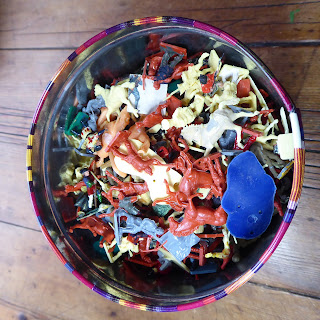 |
| Let battle commence.. |
Returning to my fictional Seven Years War campaign based on the 'Soldier King' boardgame, we last saw the Prussians attempting to co-ordinate their three separate columns in an attack on the city of Rahden, against a small but elite Austrian occupying force. Using my improvised 'mini-campaign' setup, we had the two smaller Prussian forces linking up on the western road, while Austrian cavalry kept a watchful eye.
And so, on Turn 6 of map-moving the Prussians managed to bring on their largest force from the North. The Austrians were just not getting any intelligence from the local population, however ( i.e. terrible dice rolls ), and were blissfully unaware and unable to react until Turn 7. At that point, they became aware of all three Prussian forces - what to do? Actually pretty obvious, as the first two enemy groups were much closer to the city - better meet them first! Accordingly, the Austrian infantry hastily formed up and marched out on the West road to meet the aggressors - which they pretty soon did, as shown in this hurriedly-drafted Austrian intelligence service map:
 |
| Within a table's width: contact! |
To create a battlefield, I started with the rough map above - the game table occupies '4 by 4' of the small squares, and we have the road running SW to NE, with part of the town at the NE corner. Given that, and my '9 by 9 hexes' table, I then used Bob Cordery's Terrain Generator system and rolled some dice, just to add some hills and trees. That produced four grid areas of hills and four of trees, which tended to cluster south of the road, leaving the northern section quite open - good cavalry country? Interesting.
The respective forces were as follows:
Prussians:
Brigadier-General von Stocke : 6 SPs
2 battalions Fusiliers, 1 battalion Frei Korps, all classed 'Average' and each 4 SPs
2 squadrons Uhlans ( Light Cavalry ) , Average, each 3 SPs,
1 Gun and crew, Average, 2 SPs
Total 26 SPs, exhaustion point at 9 SP lost.
Austrians:
Brigadier-General Rupert den Baren ( victor of Weihnachten ) , 6 SPs
3 Battalions Line Infantry, classed 'Elite' , each 5 SPs
2 Squadrons Heavy Cavalry , Elite, each 4 SPs
1 Gun and crew, Average, 2 SP,
Total 31 SPs , exhaustion point at 11 SPs lost.
In the board game there are no artillery units, so I decided that adding one gun for each five units was about right - so one each.
Even numbers of units, but the Prussians are about to find out that they are up against Elite troops, and their Light Cavalry have to deal with 'Heavies'. They need to at least hold the Austrians, and do some damage, while their main force tries to 'march to the sound of the guns'. The Austrians need to hit the enemy hard but also husband their own strength, ready to turn and fight the larger Prussian force.
I positioned the forces approximately as shown on the map, and so it begins: an 'encounter' battle, both sides marching into action:
 |
| Enemy in sight! Prussians nearest camera |
For rules, I am using Bob Cordery's 'Portable Napoleonic Wargame' with my homespun amendments for the Seven Years War - and also thought I'd give Mike Lewis' close combat system ( from his amendments to Bob's rules ) a try, as it does look like it might be an improvement on the original, and also distinguishes between Light and Heavy horse - useful for this battle.
And so, battle is joined... now, 'Time and Space' considerations now apply, and the outcome is going to have to wait for another time. Can the Prussians do enough to weaken those elite Austrian units? Can the Austrians sweep aside the enemy without too much loss? We shall see. Until then, keep safe and well, everyone..









